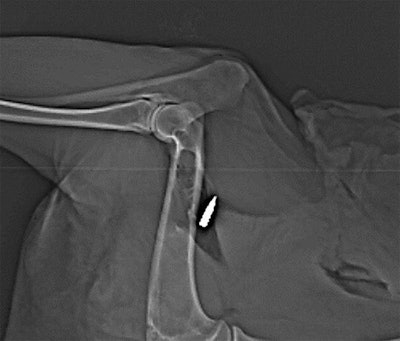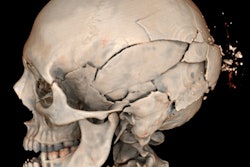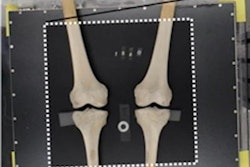
Dual-energy CT (DECT) is capable of distinguishing among various types of bullets in gunshot wounds based on their core material, which may have implications for the role radiologists play in forensics, according to an article published in the September issue of the American Journal of Roentgenology.
Noninvasive evaluations of gunshot wounds are typically performed using radiography or conventional CT, but these imaging modalities are limited in their capacity to characterize bullets. DECT, in contrast, allows clinicians to view scans at low and high energy levels and can potentially help flesh out differences between bullet types that may be critical for medical management, noted first author and radiologic technologist Dominic Gascho and colleagues from the University of Zurich.
"The noninvasive classification of retained bullets or bullet fragments into leaded or nonleaded bullets will lead to immediate medical clarification of potential lead poisoning in gunshot victims," they wrote. "Furthermore, noninvasive differentiation of bullets from common ammunition and bullets from police ammunition is of forensic interest."
 Dual-energy CT scan of bullet lodged in an animal cadaver near the humerus. Image reprinted from "Identification of bullets based on their metallic components and x-ray attenuation characteristics at different energy levels on CT," Gascho et al, AJR, September 2019, Vol. 213:3. Copyright © 2019.
Dual-energy CT scan of bullet lodged in an animal cadaver near the humerus. Image reprinted from "Identification of bullets based on their metallic components and x-ray attenuation characteristics at different energy levels on CT," Gascho et al, AJR, September 2019, Vol. 213:3. Copyright © 2019.Gascho and colleagues thus set out to test the viability of using DECT to examine various kinds of bullets embedded in an animal cadaver: eight steel-jacketed lead bullets, four brass-jacketed lead bullets, and four solid bullets consisting of a copper-zinc alloy. Only the steel-jacketed bullets were ferromagnetic (AJR, September 2019, Vol. 213:3, pp. W105-W113).
They used various combinations of tube voltages to scan the bullets multiple times with DECT; the bullets were positioned both near and far from bone and in two different directional orientations. Next, they applied the extended CT scale algorithm to the imaging data to obtain more detailed image reconstructions of the bullets. Finally, they calculated the dual-energy index of the bullets using three different voltage pairs: 80 kVp and 140 kVp, 100 kVp and 140 kVp, and 120 kVp and 140 kVp.
After analyzing the data, the researchers found that DECT was able to discern differences between the lead bullets and copper-zinc bullets, regardless of the type of jacket surrounding the bullet. The copper-zinc bullets had higher average and peak dual-energy indexes than the lead bullets by a statistically significant degree (p < 0.01). Gascho and colleagues determined that the best dual-energy pair to distinguish the different types of bullets was 120 kVp and 140 kVp.
However, the DECT scans also showed there were no statistically significant differences between the indexes of the steel-jacketed (ferromagnetic) and brass-jacketed (nonferromagnetic) lead bullets -- suggesting that the presence of steel in the bullet jacket does not affect x-ray attenuation enough to reveal differences between steel- and nonsteel-jacketed bullets.
The ability of a clinically approved dual-energy CT protocol to differentiate noninvasively between bullets with different metal cores (i.e., lead versus copper-zinc alloy) emphasizes the technology's value in assessing gunshot wounds, especially for cases in which the bullets must be left inside the body, according to the authors.
"A radiologist or radiologic technologist can perform the [DECT] measurements, and in addition to an assessment of the injuries, the radiologist can inform the police about the metallic components of the lodged bullet," they wrote.




















